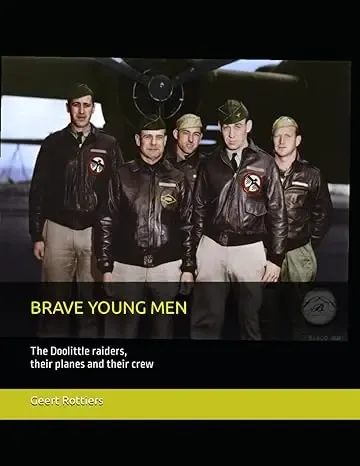Crew 01
First plane to take off from the USS Hornet on 18 April 1942

Datasheet
- Aircraft Squadron: | 34th Bomb Squadron |
- Serial number plane: | 40-2344 |
- Name of the plane: | The plane had no name - no individual markings |
- Take off date: | 18 April 1942 |
- Take off time: | Take off @ 08.20 am ship time USS Hornet |
- Place in line to take off: | 1st |
- Take off direction: | Take off @ 35 40 N 153 40 E |
- Bombs on board: | 4 cluster incendiaries |
- Bombed area in Japan: | Tokio : Waseda (Tokio) and Nishi Okubo (Tokio) |
- Bombing of Japan - local time: | between 2.15 pm and 2.25 pm |
- Fate crew - 18 april 1942: | Bailed out above China - 09.25 pm |
- Fate plane - 18 april 1942: | Crash north east of Hangzhou, China |
The Crew




Target
The story of Crew 01
Each crew/plane, except plane 16/crew 16, circled around the USS Hornet after they took off. They flew over the deck of the USS Hornet to adjust the compass and the drift sight (see included picture) was lined on the white lines painted on the deck of the USS Hornet.
Sighting of Japanese land @ 36 20 N 140 40 E
Passed Yaku Island direction Chinese coast @ 30 30 N 130 E @ 5:00 pm
Sighting of Chinese land @ 29 40 N 122 20 E @ 8.10 pm Crew was unable to find an airfied to land due to the heavy fogBailed out above occupied China @ 30 15 N 119 E @ 9.15 – 9.20 pm on 18 April 1942
Sergeant Breamer, Lieutenant Potter, Sergeant Leonard and Lieutenant Cole jumped in that order. Plane on automatic pilot. Doolittle jumped out after cutting off the fuel valves. Rainy, cloudy and misty weather. Plane crashed
Province : Zhejian province - China
Crew guided into free China by the Chinese resistance. Arrived in Chongqing, China between 18 and 25 april 1942.
FOR YOUR INFORMATION :
Each plane has a special speed where it can achieve a lift off/take off. For the B-25 Mitchell bomber is this between 90 -120 knots,
The USS Hornet turned into to wind before the take offs of the planes. Speed of the USS Hornet was 30 knots. This gave the pilots an advantage of 30 knots.
Pilot Jimmy Doolittle and the others took off with a wind of 20 knots over the flight dek of the USS Hornet.
This gave the fliers a total advantage of 50 knots.
The fliers needed 40 more knots to take off. So when the planes lift off/take off they were moving across the ground at 40 knots but the airspeed across the wings was 90 knots. Enough for them to take off.
All of the bombers had the same take off distance of 467 feet or 142.34 meters. Fliers who took off behind Pilot Jimmy Doolittle taxied forward to the same spot as pilot Jimmy Doolittle started from. The reason they did this was to minimize the risk of hitting the carrier’s “island/bridge” on the take off.
As far as how they took off, the pilots practiced techniques for getting the bomber B-25 Mitchell airborne in the shortest distance possible, also the bombers were specially lightened,
Conversions knots into km/h : https://www.metric-conversions.org/nl/snelheid/knots-naar-kilometers-per-uur.htm
Conversions knots into mph : https://www.metric-conversions.org/speed/knots-to-miles-per-hour.htm
Sergeant Paul Leonard KIA on 5 January 1943 in Algeria – in Youks-les-Bains – by enemy fire. He was reburied in Santa Fe, New Mexico.
Crew 01 - Pilot report James H. Doolittle - click here - copyright @ nara-usa - public domain
The procedure adopted for best operation efficiency for take off was as follows:
- Line up nose wheel with the white line and airplane in take off direction.
- Wing flaps in the full down position.
- Elevator trim tabs set ¾ tail heavy.
- Wheel brakes set.
- Full power – Throttles full forward and propellers in maximum RPM.
- Release brakes on signal from flag man.
- Allow airplane to roll then almost immediately ease control yoke to full back position until tail skid was about 6 inches from the deck
- As soon as airplane left the deck, ease the stick forward to gain flying speed, milk flaps up and reduce power to desired settings.
----------
3rd picture is Henry Potter in Chongqing, 26 June 1942.
4th picture : Doolittle raiders F. A. Braemer, P. J. Leonard, R. E. Cole, James Doolittle and H. A. Potter in Zhejiang Province, China, circa 19 Apr 1942.
Pictures copyright @ nara-usa - public domain
Crew picture : copyright @nara-usa - public domain - colored by : Our colorful history @ https://www.facebook.com/historyrestored - used with permission - Thank you so much for the wonderful crew pictures.
SUPPORT US ON PATREON
Please consider supporting us on Patreon for keeping this website online. Even $1 a month will go a long way. Thank you!
The Doolittle raiders, their planes
and there crew
by Mr. Geert Rottiers
Order your copy today and learn about the brave men who risked their lives to bring hope to America in the darkest days of World War II.









